Table of Contents
For the creation of solutions and manipulation of liquids, numerous vessels and apparatuses are employed in the laboratory. They differ in their intended application and precision. Volumes must always be measured at a constant temperature because changes in temperature result in volume changes owing to thermal expansion. At 10 °C, water has a substantially smaller volume than at 80 °C.
Typically, volumetric vessels are calibrated at 20 °C (25 °C in the United States). Every volumetric vessel displays the calibration temperature. Changes in temperature during the dilution of an acid, for instance, can lead to substantial errors. During dilution, significant heat is emitted and the temperature rises. When the volume of acid is measured before it has cooled, the actual volume will be lower. Therefore, the criterion for constant temperature must be observed.
Devices for measuring volume of liquids
| Device | Usual range of volumes | Accuracy |
|---|---|---|
| Erlenmayer flask, beaker | 5–5000 mL | * |
| Volumetric flask | 5–2000 mL | high |
| Volumetric cylinder | 5–2000 mL | medium |
| Burette | 1–100 mL | high |
| Pasteur pipette | 1–5 mL | low |
| Glass pipette | 1–100 mL | high |
| Pipetor | 5–5000 μL | high |
| Automatic dispenser | 0.1–100 mL | medium |
| Microsyringe | 0.5–1000 μL | high |
| piston dispenser | 1–500 ml | medium |
* not suitable for measuring volumes, only approximate volume indicated
1. Beakers
Beakers are used to estimate the volume of liquids and are therefore not always designated as measuring instruments. They are particularly utilised for dissolving chemicals, diluting liquids, heating, and other processes. Beakers are distinguished by the ‘beak’ used to pour liquids. They are typically not categorised as volumetric instruments because to their limited precision.
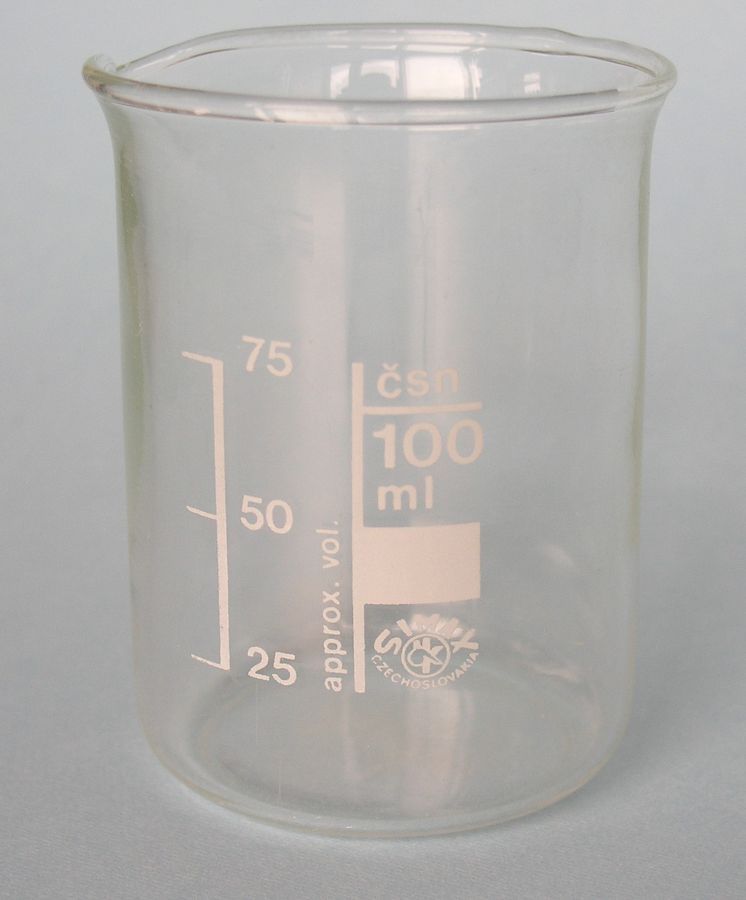
Features
- A laboratory beaker is a cylindrical container with a flat bottom, typically made of glass or plastic, and is used in a laboratory setting to hold and measure liquids.
- Beakers are generally used for tasks such as mixing, heating, and stirring chemicals, and have a spout for easy pouring.
- They are usually graduated, meaning they have markings on the side to indicate the volume of the liquid they contain.
- Beakers come in a range of sizes, from a few milliliters to several liters.
- They are a common tool in many scientific and industrial settings, and are an essential part of a well-equipped laboratory.
How to use laboratory Beakers?
To use a laboratory beaker, follow these steps:
- Choose the appropriate size beaker for your needs. Keep in mind that it’s best to use a beaker that is larger than the volume of liquid you are working with, to allow room for mixing and to prevent spills.
- Place the beaker on a flat, stable surface, such as a laboratory bench or hot plate.
- Pour the liquid into the beaker, using the spout if necessary to avoid spills.
- If you need to measure the volume of the liquid, use a graduated cylinder or a measuring cup. Alternatively, you can estimate the volume by comparing the level of the liquid to the markings on the side of the beaker.
- If you need to heat the liquid, place the beaker on a hot plate or in a water bath. Be careful not to overheat the liquid, as this can cause it to boil over or evaporate.
- If you need to mix the liquid, use a stirring rod or a stirrer. Stir gently to avoid splashing.
- When you are finished, pour the liquid out of the beaker using the spout, and rinse the beaker with water to remove any residue. Dry the beaker thoroughly before storing it.
It’s important to handle laboratory beakers with care, as they are made of fragile materials and can break if handled improperly. Always use caution when working with hot liquids, and follow all safety guidelines and protocols when working in a laboratory setting.
Applications of laboratory Beakers
Laboratory beakers have a wide range of applications in scientific and industrial settings. Some common uses for beakers include:
- Mixing and stirring chemicals: Beakers are often used to mix and stir chemicals, as they have a flat bottom and a spout that makes it easy to pour the mixture.
- Heating and cooling: Beakers can be placed on a hot plate or in a water bath to heat liquids, or in a refrigerator or freezer to cool them.
- Measuring volume: Beakers are often graduated, meaning they have markings on the side indicating the volume of the liquid they contain. This makes them useful for measuring the volume of liquids.
- Transferring liquids: Beakers can be used to transfer liquids from one container to another, using the spout to control the flow of the liquid.
- Storage: Beakers can be used to store liquids in the laboratory, as long as they are stored in a secure location and are not used to store hazardous chemicals.
In addition to these applications, beakers are also used in a wide range of other tasks in scientific and industrial settings, including chemical reactions, distillation, and solvent extraction. They are an essential tool in many laboratory settings, and are a common sight in scientific research facilities, industrial labs, and educational settings.
2. Volumetric Flasks and Cylinders
Cylinders and flasks with volumetric measurements are used to measure the volume of liquids contained within them. They are calibrated for the volume they contain, as shown by the label “IN.” When the liquid reaches the correct marking on the scale, its volume is exact. Typically, volume is stated in millilitres. During volume measurement, the vessel must be supported horizontally and evenly. The required volume is measured when the lower edge of the liquid’s meniscus slightly touches the vessel’s marking. Cylinders are less precise than volumetric flasks, which are used to prepare exact concentration solutions. Cylinders are only used for volume measurement; they are not utilised for dissolving, dilution, or mixing.
Volumetric Flasks
A volumetric flask is a type of laboratory glassware used to measure and mix precise volumes of liquids. It is shaped like a flat-bottomed flask with a narrow neck and a round body, and has a volume mark on the neck indicating the volume it is designed to hold. Volumetric flasks are used to prepare standard solutions, which are solutions of known concentration that are used to calibrate other equipment or as reference materials.
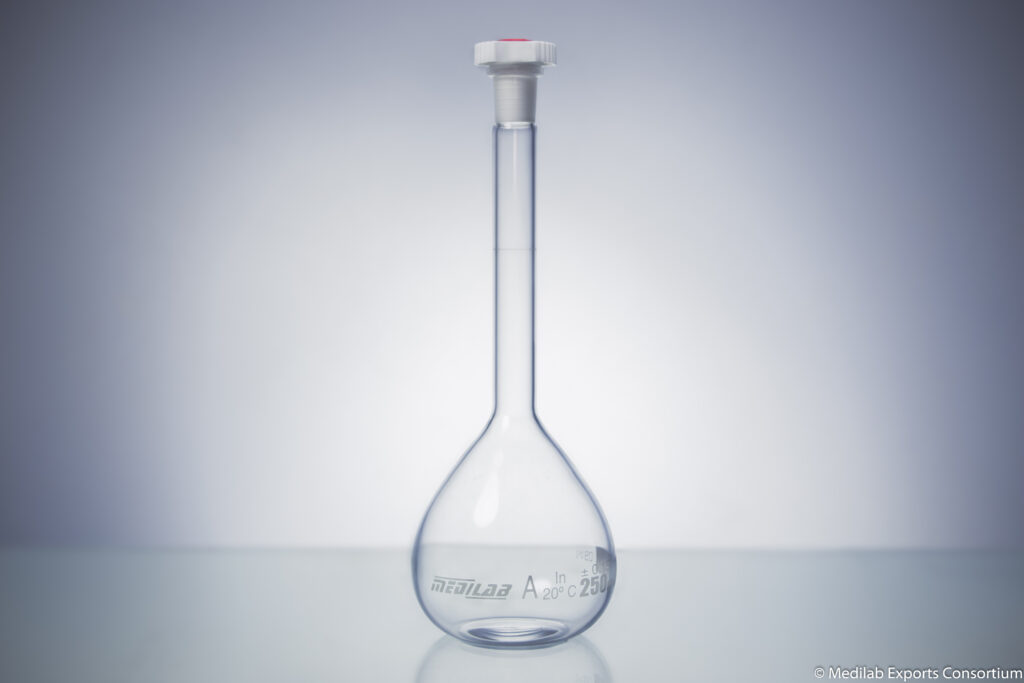
To use a volumetric flask, follow these steps:
- Choose the appropriate size volumetric flask for your needs. Volumetric flasks are available in a range of sizes, from a few milliliters to several liters.
- Rinse the volumetric flask with deionized water or the solvent you will be using, to remove any dust or contaminants.
- Pour the solvent into the volumetric flask until it reaches the mark on the neck indicating the desired volume.
- Add the solute (the substance being dissolved) to the solvent in the volumetric flask.
- Stir the mixture until the solute is completely dissolved.
- If necessary, add additional solvent until the mixture reaches the mark on the neck indicating the desired volume.
- Close the volumetric flask with a stopper and shake it gently to ensure that the solution is well mixed.
- Once the solution is prepared, you can use it as a reference material or to calibrate other equipment.
It’s important to handle volumetric flasks with care, as they are made of fragile materials and can break if handled improperly. Always follow all safety guidelines and protocols when working in a laboratory setting.
Volumetric Cylinders
A volumetric cylinder, also known as a graduated cylinder, is a laboratory glassware used to measure the volume of a liquid. It is a long, narrow cylinder with a round base and a narrow neck, and has volume markings on the side indicating the volume it is capable of holding. Volumetric cylinders are used to measure the volume of a liquid accurately and precisely, and are often used in scientific experiments and quality control processes.
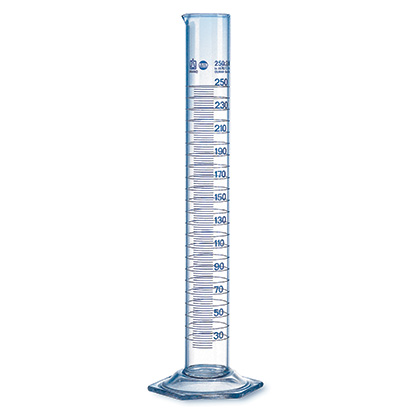
To use a volumetric cylinder, follow these steps:
- Choose the appropriate size volumetric cylinder for your needs. Volumetric cylinders are available in a range of sizes, from a few milliliters to several liters.
- Place the volumetric cylinder on a flat, stable surface.
- Slowly pour the liquid into the volumetric cylinder, taking care not to let it overflow or spill.
- Look at the side of the volumetric cylinder to determine the volume of the liquid. The volume is indicated by the point at which the surface of the liquid touches the markings on the side of the cylinder.
- If you need to measure a volume that falls between two markings on the cylinder, estimate the volume by comparing the level of the liquid to the markings.
- Once you have measured the volume, pour the liquid out of the volumetric cylinder using the spout or the bottom of the cylinder.
- Rinse the volumetric cylinder with water to remove any residue, and dry it thoroughly before storing it.
It’s important to handle volumetric cylinders with care, as they are made of fragile materials and can break if handled improperly. Always follow all safety guidelines and protocols when working in a laboratory setting.
Applications of Volumetric Flasks and Cylinders
Volumetric flasks and cylinders have a range of applications in scientific and industrial settings, where accurate measurement of the volume of liquids is important. Some common uses for volumetric flasks and cylinders include:
- Preparing standard solutions: Volumetric flasks are often used to prepare standard solutions, which are solutions of known concentration that are used to calibrate other equipment or as reference materials.
- Measuring volume: Both volumetric flasks and cylinders are used to measure the volume of liquids accurately and precisely. They are particularly useful for measuring small volumes, as they are capable of measuring down to the milliliter.
- Mixing and stirring chemicals: Volumetric flasks can be used to mix and stir chemicals, as they have a narrow neck and a round body that allows for easy stirring.
- Quality control: Both volumetric flasks and cylinders are used in quality control processes to ensure that the volume of a product is within the specified range.
- Research and development: Volumetric flasks and cylinders are commonly used in research and development settings to measure and mix precise volumes of liquids.
In addition to these applications, volumetric flasks and cylinders are also used in a wide range of other tasks in scientific and industrial settings, including chemical reactions, distillation, and solvent extraction. They are an essential tool in many laboratory settings, and are a common sight in scientific research facilities, industrial labs, and educational settings.
3. Burettes
Burettes are utilised for titrations or when measuring the same liquid repeatedly. Burette is a tube made of glass or plastic with a calibrated scale and a stopcock. A vertically positioned burette is fastened to a stand. With the vent closed, the measured liquid is added. Then, liquid is poured until the meniscus contacts the scale’s indication. The burette is now prepared for titration. The liquid is poured using the stopcock, and its volume is determined using a scale. Reading the volume is the most crucial step; using a burette, the volume is always read twice: first to determine the beginning point of the meniscus, and then again to determine the end position. As the volume difference is determined, it does not matter how precisely the volume is read; however, it must be read in the same manner each time. In standard laboratories, automatic burettes are utilised.

How to use Burettes?
A burette is a laboratory glassware used to measure and dispense precise volumes of liquids. It is a long, narrow tube with a tap at one end and a graduated scale on the side, and is often used in titration experiments to measure the volume of a liquid being added to a solution. To use a burette, follow these steps:
- Choose the appropriate size burette for your needs. Burettes are available in a range of sizes, from a few milliliters to several liters.
- Rinse the burette with the liquid you will be measuring, to remove any dust or contaminants.
- Open the tap at the bottom of the burette and allow the liquid to flow until it reaches the zero mark on the graduated scale. This is known as “zeroing” the burette.
- Close the tap and add the liquid to the burette until it reaches the desired volume.
- Open the tap and dispense the liquid by allowing it to flow out of the burette.
- Close the tap when the desired volume has been dispensed.
- Record the volume of the liquid dispensed in your laboratory notebook.
It’s important to handle burettes with care, as they are made of fragile materials and can break if handled improperly. Always follow all safety guidelines and protocols when working in a laboratory setting.
Applications of Burettes
Burettes are a versatile and precise tool in the laboratory, and have a wide range of applications in scientific and industrial settings, where accurate measurement of the volume of liquids is important. Some common uses for burettes include:
- Titration: Burettes are commonly used in titration experiments, which is a method used to determine the concentration of an unknown solution by adding a known solution of known concentration. In titration, a burette is used to measure and dispense a precise volume of the solution of known concentration (the titrant) into a solution of unknown concentration (the analyte), until a specific reaction is reached (endpoint).
- Volume measurements: Burettes can be used to measure volume of a liquid, usually in milliliters, they are accurate and precise.
- Quality control: Burettes are often used in quality control processes to ensure that the volume of a product is within the specified range.
- Research and development: Burettes are commonly used in research and development settings to measure and dispense precise volumes of liquids in experiments.
- Chemistry education: Burettes are a common tool in the laboratory and are frequently used in the teaching of chemistry in schools and universities.
- Industrial applications: Burettes are also used in industrial settings such as manufacturing and chemical process industries.
It’s important to note that burettes must be calibrated correctly before use and should be checked for any leaks or damage and must be cleaned before and after use to avoid errors and maintain accuracy. Additionally, the user should be well trained in using burettes and follow the standard laboratory procedures to guarantee the accurate and precise results.
4. Glass pipettes
In modern routine laboratories, glass pipettes are rarely used; they have been replaced with semiautomatic dispensers. The volume of glass pipettes can range between 1 and 100 millilitres. For measuring a specific volume, glass pipettes can be unscaled or scaled with grades by 1 mL and tenths of a millilitre. The scale may be numbered from the bottom up or the reverse manner.
Due to security concerns, liquids should never be inhaled through the mouth. Instead, several adapters and pistons are utilised.
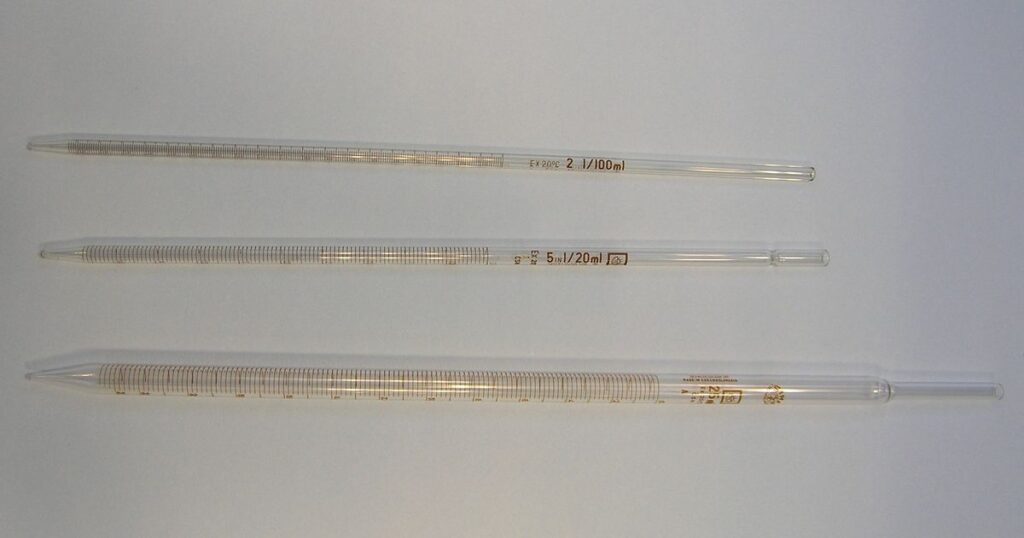
When aspirating the solution, the pipette must never touch the vessel’s bottom. Before measuring a sample, the pipette must be filled with the solution, which is then discarded. The exact quantity is then measured and provided for subsequent processing. Never allow the measured solution to enter the adapter.

Pipettors (automatic pipettes, micropipettes, microdispensers).
Automatic pipettes, also known as electronic or motorized pipettes, are laboratory instruments used for dispensing and aspirating precise volumes of liquid. They are commonly used in chemical analysis, clinical laboratory testing, and other fields where accurate and repeatable liquid handling is required.
Automatic pipettes are powered by batteries or an AC adapter and use a motor to control the movement of the plunger, which draws liquid into the pipette and dispenses it out. This makes it much easier and more accurate to dispense precise volumes of liquid compared to manual pipettes, which rely on the user to manually control the plunger.
There are several different types of automatic pipettes available, each designed for specific applications. One common type is the single-channel pipette, which is designed for dispensing one specific volume of liquid at a time. Another common type is the multi-channel pipette, which can dispense multiple aliquots of the same volume at once.
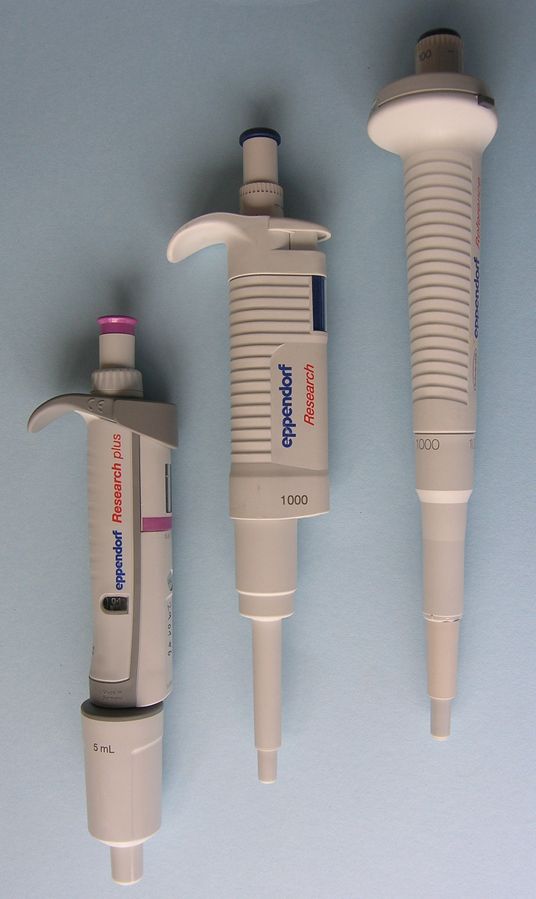
Micropipettes, also known as micromanipulators, are similar to standard automatic pipettes but are designed to handle very small volumes of liquid, typically in the range of microliters (μL) to nanoliters (nL). These are commonly used in molecular biology, genetic engineering, and other fields where small volumes of liquid are used.

Microdispensers, also known as nanolitre dispensers, similar to micropipettes which specifically handle even smaller volume (nanoliters) and are used in advanced biotech research, protein crystallography, and for high-throughput screening assays. These dispensers have the ability to dispense and aspirate very small volumes of liquid with high precision and accuracy.
In summary, automatic pipettes, micropipettes, and microdispensers are laboratory instruments used for precise and accurate liquid handling. They are powered by batteries or an AC adapter, and use a motor to control the movement of the plunger. They are commonly used in fields such as chemical analysis, clinical laboratory testing, molecular biology, genetic engineering and biotechnology.
How to use Glass pipettes?
Using glass pipettes properly is important for ensuring accurate and repeatable liquid handling. Here are the basic steps for using glass pipettes:
- First, ensure that the glass pipette is clean and dry. This is important to prevent contamination of the liquid being handled and to ensure accurate volume measurements.
- Before using the pipette, check that the volume is correct. This can usually be done by checking the mark on the pipette against a ruler or other measuring device.
- To fill the pipette with liquid, position the tip of the pipette in the liquid, making sure to keep the pipette at an angle to prevent any bubbles from entering. Slowly draw the liquid into the pipette by pulling the plunger upwards.
- Once the desired volume of liquid is in the pipette, remove the tip from the liquid. It is important to keep the pipette upright and to avoid shaking it to prevent any loss of liquid or change in volume.
- To dispense the liquid, position the tip of the pipette over the recipient vessel and slowly push the plunger downwards to release the liquid.
- After dispensing, it is important to clean the pipette, which could be either by blowing out the remaining liquid or wiping it dry with a lint-free cloth.
- Properly store the pipettes to maintain the integrity and accuracy of the instrument, this includes keeping them dry and clean.
It’s important to note that for specific tasks or protocols, the steps and techniques may vary, it’s always best to check the specific instructions provided by the lab or the manufacturer of the glass pipettes you’re using.
It is also important to note that glass pipettes are fragile, and should be handled with care to prevent breakage. Additionally, using glass pipettes in hazardous environments or with hazardous materials should be done only with the proper precautions and training.
How to use Automatic pipettes?
Using automatic pipettes is similar to using manual pipettes, but with the added convenience and precision of the motorized mechanism. Here are the basic steps for using automatic pipettes:
- First, ensure that the automatic pipette is clean and dry. This is important to prevent contamination of the liquid being handled and to ensure accurate volume measurements.
- Before using the pipette, check that the volume is set correctly. This can usually be done by checking the digital display or the adjustment knob on the pipette.
- To fill the pipette with liquid, position the tip of the pipette in the liquid, making sure to keep the pipette at an angle to prevent any bubbles from entering. Press the “aspirate” button or the trigger to draw the liquid into the pipette. The motor will automatically control the movement of the plunger to aspirate the desired volume of liquid into the pipette.
- Once the desired volume of liquid is in the pipette, remove the tip from the liquid and release the trigger. It is important to keep the pipette upright and to avoid shaking it to prevent any loss of liquid or change in volume.
- To dispense the liquid, position the tip of the pipette over the recipient vessel and press the “dispense” button or trigger to release the liquid. The motor will automatically control the movement of the plunger to dispense the liquid.
- After dispensing, it is important to clean the pipette, this includes wiping it dry with a lint-free cloth or blowing out the remaining liquid.
- Properly store the pipettes to maintain the integrity and accuracy of the instrument. This includes keeping them dry and clean, as well as recharging or replacing batteries if necessary.
It’s important to note that different models of automatic pipettes may have different buttons or controls, so it’s a good idea to refer to the manufacturer’s instructions for specific details on how to use your particular model. Additionally, it is important to read the manual before using the pipette to understand the safety precautions, troubleshoot and maintenance requirements of the instrument.
Applications of pipettes
Pipettes, both manual and automatic, are commonly used in a wide range of scientific, medical and industrial applications. Here are a few examples of how pipettes are used:
- In chemistry, pipettes are used for preparing solutions, measuring precise volumes of reagents, and performing titrations.
- In biology and medicine, pipettes are used for handling small volumes of biological samples, such as blood or urine, as well as for dispensing precise volumes of reagents in diagnostic tests or research experiments.
- In research and biotechnology, pipettes are used in the handling and dispensing of samples and reagents in molecular biology, genetics, protein chemistry, and cell culture.
- In forensic science, pipettes are used for collecting and analyzing samples of blood, DNA, or other biological material from crime scenes.
- In food and beverage industry, pipettes are used for dispensing and measuring small volumes of ingredients, fluids, and other substances.
- In the pharmaceutical industry, pipettes are used to accurately measure and handle small volumes of drugs and other chemicals during the manufacturing and formulation process.
- In environmental science, pipettes are used for measuring and analyzing water, soil, and air samples.
- In academia, pipettes are commonly used in the laboratory and classroom settings for demonstration, training and experimentation.
In summary, pipettes are widely used in a variety of fields, including chemistry, biology, medicine, research, biotechnology, forensic science, food and beverage industry, pharmaceuticals, environmental science, and academia. They are essential tools for measuring and dispensing small volumes of liquids with high accuracy and precision.
5. Microsyringes
Microsyringes are used to dispense liquids in small volumes (0.1–1000 μL). A needle is fitted to a scaled glass cylinder containing a piston. The needle and piston diameters of various models vary.
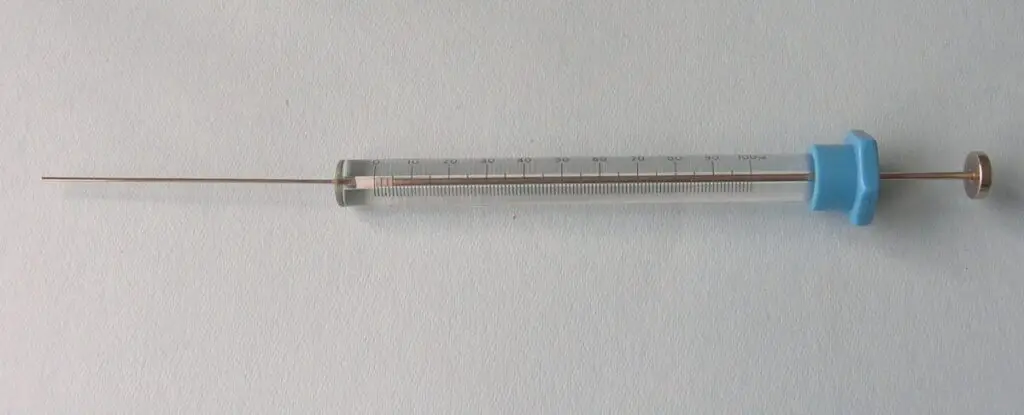
How to use Microsyringes?
Microsyringes, also known as microneedle syringes, are laboratory instruments used for dispensing and aspirating precise volumes of liquid. They are similar to standard syringes, but are designed to handle very small volumes of liquid, typically in the range of microliters (μL) to nanoliters (nL).
Here are the basic steps for using a microsyringe:
- First, ensure that the microsyringe is clean and dry. This is important to prevent contamination of the liquid being handled and to ensure accurate volume measurements.
- Before using the microsyringe, check that the volume is correct. This can usually be done by checking the mark on the syringe against a ruler or other measuring device.
- To fill the microsyringe with liquid, position the needle of the microsyringe in the liquid, making sure to keep the microsyringe at an angle to prevent any bubbles from entering. Slowly draw the liquid into the microsyringe by pulling the plunger upwards.
- Once the desired volume of liquid is in the microsyringe, remove the needle from the liquid. It is important to keep the microsyringe upright and to avoid shaking it to prevent any loss of liquid or change in volume.
- To dispense the liquid, position the needle of the microsyringe over the recipient vessel and slowly push the plunger downwards to release the liquid. It is important to use appropriate needle gauge to prevent damage to cells or samples.
- After dispensing, it is important to clean the microsyringe, which could be either by blowing out the remaining liquid or wiping it dry with a lint-free cloth.
- Properly store the microsyringe to maintain the integrity and accuracy of the instrument, this includes keeping it dry and clean, also properly dispose of the needle after each use to prevent injury.
Applications of Microsyringes
Microsyringes are widely used in a variety of fields, including chemistry, biology, medicine, research, and biotechnology. Here are a few examples of how microsyringes are used:
- In chemistry, microsyringes are used for preparing solutions, measuring precise volumes of reagents, and performing titrations.
- In biology and medicine, microsyringes are used for handling small volumes of biological samples, such as blood or urine, as well as for dispensing precise volumes of reagents in diagnostic tests or research experiments.
- In research and biotechnology, microsyringes are used in the handling and dispensing of samples and reagents in molecular biology, genetics, protein chemistry, and cell culture.
- In drug delivery, microsyringes are used to precisely inject small volumes of drugs or other substances into the body.
- In forensic science, microsyringes are used for collecting and analyzing samples of blood, DNA, or other biological material from crime scenes.
- In the pharmaceutical industry, microsyringes are used to accurately measure and handle small volumes of drugs and other chemicals during the manufacturing and formulation process.
- In environmental science, microsyringes are used for measuring and analyzing water, soil, and air samples.
- In academia, microsyringes are commonly used in the laboratory and classroom settings for demonstration, training and experimentation.
In summary, microsyringes are widely used in a variety of fields, including chemistry, biology, medicine, research, biotechnology, forensic science, drug delivery, pharmaceuticals, environmental science, and academia. They are essential tools for measuring and dispensing small volumes of liquids with high accuracy and precision. Their design allows for precise, small-volume injection which make them unique tool and a specific use case.
6. Piston dispensers
The components of piston dispensers are a piston with a scale coupled to a flask. They are designed for repeated dispensing of the same amount from the supply container. Dispensers designed for measuring hostile liquids (e.g., strong acids) are made of borosilicate glass; plastic components in touch with the measured liquid are made of PTFE, and the other plastic parts are made of PE or PP. Electronic control modules may automate dispensing in current dispensers.

How to use Piston dispensers?
Piston dispensers, also known as manual dispensers, are laboratory instruments used for dispensing and aspirating precise volumes of liquid. They are similar to standard syringes, but have a mechanism which allows the plunger to move in a smooth and consistent manner.
Here are the basic steps for using a piston dispenser:
- First, ensure that the piston dispenser is clean and dry. This is important to prevent contamination of the liquid being handled and to ensure accurate volume measurements.
- Before using the dispenser, check that the volume is correct. This can usually be done by checking the mark on the dispenser against a ruler or other measuring device.
- To fill the dispenser with liquid, position the tip of the dispenser in the liquid, making sure to keep the dispenser at an angle to prevent any bubbles from entering. Slowly draw the liquid into the dispenser by pulling the plunger upwards using the knob or lever provided.
- Once the desired volume of liquid is in the dispenser, remove the tip from the liquid. It is important to keep the dispenser upright and to avoid shaking it to prevent any loss of liquid or change in volume.
- To dispense the liquid, position the tip of the dispenser over the recipient vessel and slowly push the plunger downwards using the knob or lever provided.
- After dispensing, it is important to clean the dispenser, which could be either by blowing out the remaining liquid or wiping it dry with a lint-free cloth.
- Properly store the dispenser to maintain the integrity and accuracy of the instrument, this includes keeping it dry and clean.
It’s important to note that for specific tasks or protocols, the steps and techniques may vary, it’s always best to check the specific instructions provided by the lab or the manufacturer of the piston dispenser you’re using. Additionally, it is important to read the manual before using the dispenser to understand the safety precautions, troubleshoot and maintenance requirements of the instrument.
It is also important to note that piston dispensers, like other lab instruments, should be handled with care to prevent breakage and to ensure accurate and repeatable results. Additionally, using piston dispensers in hazardous environments or with hazardous materials should be done only with the proper precautions and training.
Applications of Piston dispensers
Piston dispensers are commonly used in a variety of industries for dispensing a variety of fluids and semi-viscous materials. Some common applications include:
- Pharmaceuticals: Piston dispensers are used in the pharmaceutical industry for dispensing precise amounts of medicine and other liquid medications.
- Cosmetics: Piston dispensers are used in the cosmetics industry for dispensing lotions, creams, and other personal care products.
- Food and Beverage: Piston dispensers are used in the food and beverage industry for dispensing condiments, sauces, and other food products.
- Industrial: Piston dispensers are used in industrial applications for dispensing adhesives, lubricants, and other industrial fluids.
- Laboratory: Piston dispensers are used in laboratory applications for dispensing small amounts of liquids and chemicals, they are commonly found in school and research labs.
- Home and Garden: Piston dispensers can be used at home for dispensing cleaning solutions, lubricants and even gardening fertilizer in the garden.
In general, piston dispensers are used in any application where precise, controlled dispensing of liquids and semi-viscous materials is required.
